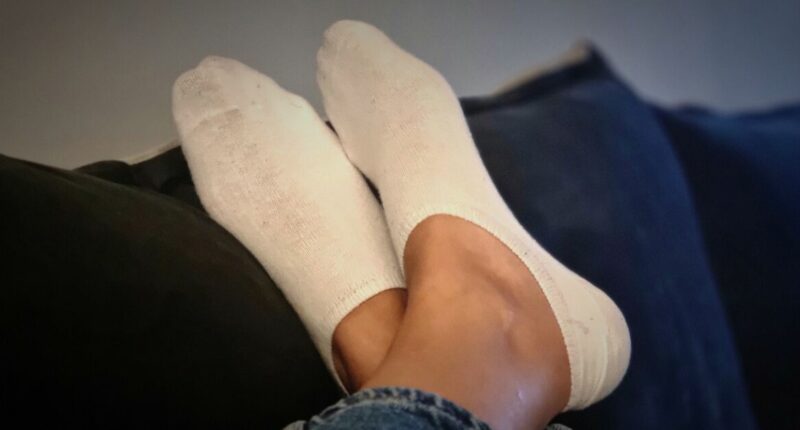Share this @internewscast.com
A microbiologist has warned Britons are failing to see the danger lurking in our socks – as our feet are “microbial hotspots” spreading a host of killer pathogens, which can cause disease. Dr Primrose Freestone, Associate Professor in Clinical Microbiology at the University of Leicester, says the area between our toes is packed with sweat glands and wearing socks traps that moisture in a humid, microbial cocoon,
In fact, our feet are home to a “miniature rainforest of bacteria and fungi”, with anywhere from 100 to 10 million microbial cells per square centimetre of skin surface. Now writing in The Conversation she says we’re washing our socks at too low a temperature and failing to shield ourselves from a deadly range of infections including “Aspergillus, Staphylococcus, Candida, Histoplasma and Cryptococcus.”
Dr Freestone explains: “Your feet are microbial hotspots. The area between your toes is packed with sweat glands, and when we wrap our feet in socks and shoes, we trap that moisture in a warm, humid cocoon that’s ideal for microbial growth.
“In fact, your feet may be home to a miniature rainforest of bacteria and fungi, with anywhere from 100 to 10 million microbial cells per square centimetre of skin surface.
“Not only do feet host a huge variety of microorganisms – up to 1,000 different species per person – but they also have a wider range of fungal species than any other part of the body. That means your feet aren’t just sweaty or smelly – they’re genuinely biodiverse.
“Because your feet are microbe-rich, your socks become prime real estate for these same bacteria and fungi.
“Studies show that socks harbour both harmless skin residents, like coagulase-negative staphylococci, and potentially dangerous pathogens, including Aspergillus, Staphylococcus, Candida, Histoplasma and Cryptococcus.
“These microbes thrive in the warm, moist spaces between your toes, feeding on sweat and dead skin cells.
“Their byproducts, such as volatile fatty acids and sulphur compounds, are what give sweaty feet, socks and shoes that notorious odour. It’s not the sweat itself that smells, but the microbial metabolism of that sweat.
“Perhaps unsurprisingly, smelly feet are so common the NHS has dedicated pages of advice on the issue.
“The sock microbiome isn’t just influenced by your feet – it also reflects your environment. Socks pick up microbes from every surface you walk on, including household floors, gym mats, locker rooms and even your garden.
“They act as microbial sponges, collecting bacteria and fungi from soil, water, pet hair and dander, and the general dust of everyday life.
“In one study, socks worn for just 12 hours had the highest bacterial and fungal counts of any clothing item tested.
“And those microbes don’t stay put. Anything living in your socks can transfer to your shoes, your floors, your bedding – and even your skin.
“In a hospital study, slipper socks worn by patients were found to carry floor microbes, including antibiotic-resistant pathogens, into hospital beds.
“It’s a reminder that foot hygiene isn’t just a personal issue – it can have broader implications for infection control and public health.”
SUPER-SPREADERS:
“Socks can also play a key role in spreading fungal infections like Tinea pedis (better known as athlete’s foot), a highly contagious condition that primarily affects the toes but can spread to the heels, hands, or even the groin.
“The infection is caused by dermatophyte fungi, which love warm, damp environments – exactly the kind you find in sweaty socks and tight shoes.
“To prevent this, experts recommend avoiding walking barefoot in shared spaces like gyms and pools, not sharing socks, towels, or shoes, and practising good foot hygiene, which includes washing and drying thoroughly between the toes. Topical antifungal treatments are usually effective, but prevention is key.
“It’s also important to note that socks can retain fungal spores even after washing. So if you’ve had athlete’s foot, wearing the same pair again – even if it looks clean – could trigger reinfection.
“The safest approach is to wear fresh socks daily and allow your shoes to dry out completely between wears. Choose breathable fabrics and avoid footwear that traps heat or causes excessive sweating.”
HOW TO WASH YOUR SOCKS PROPERLY:
“Most laundry advice focuses on preserving fabric, colour and shape – but when it comes to socks, hygiene matters more. Studies show that washing at typical domestic temperatures (30–40°C) may not be sufficient to kill bacteria and fungi. In fact, under-cleaned socks can act as infection vectors, especially in households with vulnerable people.
“Cotton socks tend to tolerate higher temperatures better than synthetic blends, making them a better option for those prone to fungal infections. Drying socks in direct sunlight can also help: UV light has known antimicrobial effects.
THE FORENSIC POWER OF MICROBIOMES:
“Your socks might say more about you than you realise. In a US murder investigation, forensic scientists used soil bacteria found on a suspect’s socks to link them to the burial site of a victim.
“The microbial profile of the socks closely matched that of the crime scene – suggesting the socks had picked up and preserved location-specific soil microbes. This emerging field of forensic microbiology shows how microbial signatures can offer valuable clues in legal contexts.
“It’s a reminder that the ecosystems we carry on our bodies – and in our clothing – are not only complex and revealing but also surprisingly durable. Whether it’s helping to solve crimes or fuelling a fungal outbreak, your socks are far more biologically active than they appear.
“So next time you peel off a sweaty pair at the end of the day, spare a thought for the microscopic universe you’ve been walking around in. And maybe, just maybe, opt for that 60-degree wash.”










